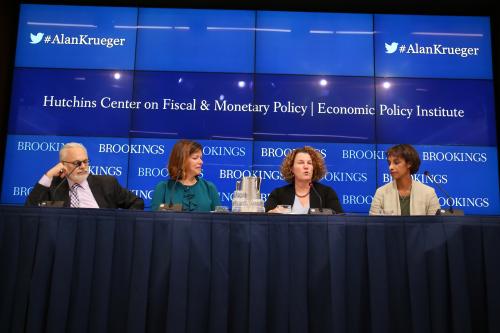On January 3, 2020 at the Allied Social Science Association (ASSA) annual meetings in San Diego, California—the largest annual gathering of economists—I participated in a panel hosted by the American Economics Association (AEA) titled, “How Can Economics Solve Its Race Problem?” The panel was convened by Janet Yellen, Former Federal Reserve Board Chair, current AEA President, and Distinguished Fellow in Residence at Brookings, and moderated by Ebonya Washington, the Samuel C. Park Jr. Professor of Economics at Yale University. Fellow panelists included Drs. Trevon Logan, Marie Mora, Ted Miguel and Cecilia Conrad.
This was the first time in many years that such a panel was held at the ASSA meetings. Nevertheless, this has been an important topic of concern for many in the profession for decades. For instance, this year marks the 50th anniversary of the National Economics Association (NEA), which grew out of the Caucus of Black Economists and was established, in part, to “promote the professional lives of minorities within the profession.” The NEA has inspired the founding and creation of additional organizations with related missions, such as the American Society of Hispanic Economists (ASHE), founded in 2002, and the Association for Economic Research of Indigenous Peoples (AERIP), founded just last year and for which I serve as the president-elect.
The economics profession is less diverse than the general population by race and gender. The lack of diversity has received increased attention in recent years due to incidents that have come to light about harassment and discrimination in the profession for women and minorities both online and in employment situations. The disparities in the economics profession are quite stark. Only 30 percent of Ph.D. economists in the federal government and 23 percent of economics faculty in academia are women. Twenty-four percent of Ph.D. economists in the federal government and 21 percent of economics faculty in academia are minorities (Black, Hispanic, Asian, and other minorities).
Our AEA panel focused on racial and ethnic representation in economics and how to increase diversity in the profession. Dr. Washington asked us all to expand on some of the benefits of increasing racial and ethnic diversity for the economics profession. One immediate response was that the diversity of perspectives and experiences enriches the discipline and increases the opportunity for novel research endeavors. I explained how my background, experience and prior work has provided me with a comparative advantage in undertaking research topics related to Indigenous Peoples because of my familiarity and exposure to certain programs and policies. In fact, some of my most successful publications have evolved out of my own experiences or that of friends and family. Similarly, Dr. Trevon Logan (in a series of tweets) indicated how his grandmother’s experience with residential segregation led to a series of papers and publications based on the “lived black experience, as opposed to aracial theorizing”. These are the kinds of contributions that we miss out on due to the lack of diversity in economics.
While there are potential benefits to diversity in economics, there are significant obstacles that remain for underrepresented minorities, women, or individuals from developing countries. In my opinion there is a great deal of implicit bias in the profession at all stages from entering undergraduate majors all the way to tenure and promotion. At the panel discussion, I mentioned at least four critical junctures where I have observed bias play a role in limiting the discipline and profession. The first is at the time of admissions to graduate programs; the second occurs when departments rank their graduate students for placement on the academic job market; the third occurs during the hiring process; and the fourth occurs at promotion and tenure decisions. At each of these critical stages, these biases can affect outcomes that perpetuate existing racial and gender disparities.
For instance, it is common to hear that women economists are expected by students, other faculty and staff to be warm, open and inviting; in a word, they are expected to be “motherly”. When a woman deviates from this expectation, they are labeled as “cold” or “unfriendly”. This type of unconscious bias then has the potential for longer-term impacts on hiring, promotion and tenure. Couple this particular gender bias with other biases related to race (or ethnicity) and it is not difficult to understand why there is such a lack of underrepresented minority women in the economics profession. We could introduce issues of class, foreign-born status, and foreign accents which bring their own additional issues of implicit bias.
There is no simple solution to this problem; implicit biases are long-held and difficult to change. Nevertheless, we should try. Recognizing that we each hold different kinds of biases is an important first step and not something that is taught in a standard economics graduate program. There needs to be increased acknowledgement of the positions of privilege that we occupy in the profession whether it be across gender, race, foreign-born status, class lines or a combination of these. In fact, required training or courses on implicit bias may be a useful undertaking for economics departments and for economists in general.
The Brookings Institution is committed to quality, independence, and impact.
We are supported by a diverse array of funders. In line with our values and policies, each Brookings publication represents the sole views of its author(s).




Commentary
The race problem in economics
January 22, 2020